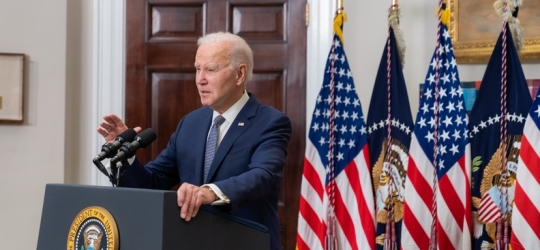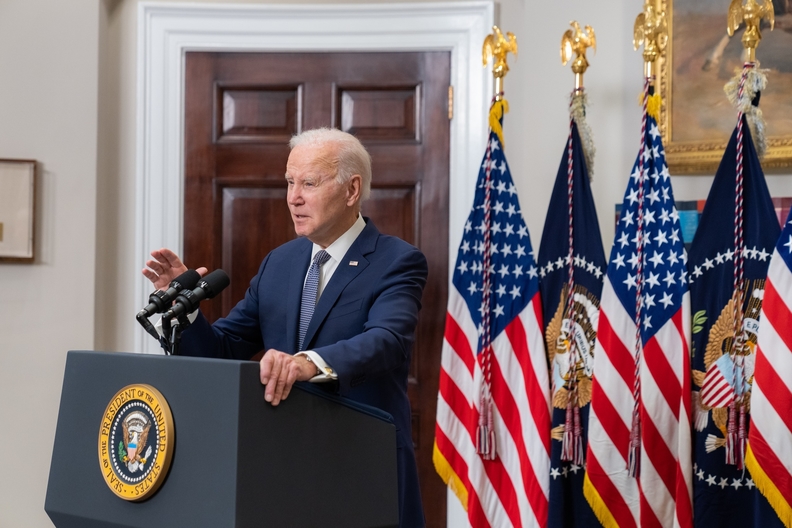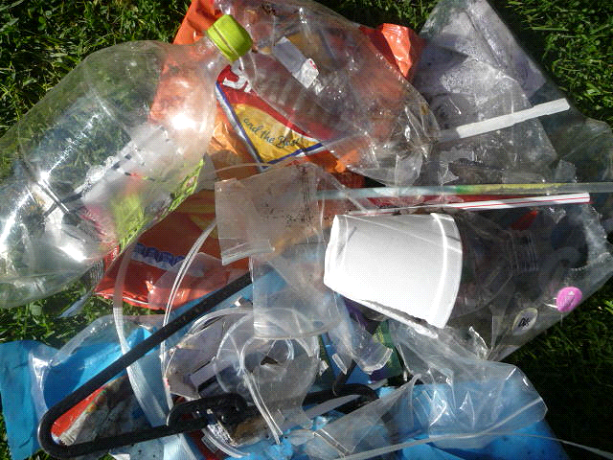
Industry sees Biden bioplastics goal as serious signal – USA
Posted on April 2, 2023 by DrRossH in BioPlastics, Plastic Recycling, Plastic Waste News
The White House’s ambitious bioplastics goals announced March 22 face many hurdles but some in that nascent industry see it as a clear sign that President Joe Biden’s administration wants to support more climate-friendly manufacturing.
The White House Office of Science and Technology Policy’s new bioeconomy road map calls for replacing 90 percent of traditional plastics with bio-based materials in 20 years.
The 64-page report, which outlines what it acknowledges are “bold goals,” is short on details of how to get there, saying the OSTP will work out research and development priorities and other actions in coming months.
One called it “pure fantasy” to suggest the switch could happen in 20 years.
But some bioplastics executives said they liked the message and support from Washington.
“Even if the targets are missed, I think this is a major step in the right direction,” said Stephen Croskrey, CEO of PHA maker Danimer Scientific Inc. in Bainbridge, Ga. “Danimer believes the administration is serious about accelerating the adoption of bio-based alternatives.”
“Clearly these are extremely challenging objectives, but we hope that they lead to new, innovative programs to help facilitate the transition to bio-based materials like ours, which deliver clear environmental benefits compared to conventional petroleum-based plastics,” said Croskrey, who participated in a September White House roundtable on the bioeconomy.
As well, Mark Remmert, CEO of bio-elastomer maker Green Dot Bioplastics Inc. in Emporia, Kan., said it’s a strong statement coming from Biden and the White House.
“Who knows how much of this makes it into any kind of budget action but for the most visible person on the planet to stand up and say we need to move away from traditional plastics and replace materials with bioplastics, that’s a big statement,” Remmert said.
Still, both pointed to major implementation challenges.
Croskrey said the federal government should set up incentives and help facilitate investment.
“The federal government can incentivize and/or mandate adoption of sustainable materials,” he said. “Without economies of scale, most sustainable materials are more expensive than conventional petroleum-based plastics. Creating demand for sustainable materials will speed up development and lead to where they make more sense economically.”
The government should also support more R&D and capacity building, he said: “In order to hit these targets, a huge investment in fermentation infrastructure will be required.”
“It took us more than 100 years to get to where we are with traditional plastics,” he said. “I don’t think we’re going to replace all that in 20 years but… [having] big goals set out there in the horizon that people can steer toward, that’s quite helpful.”
He said the government should focus on replacing single-use plastics and said there are many good uses of traditional plastics, such as medical devices or in auto parts that make cars lighter and improve fuel efficiency.
Remmert compared bioplastics today to green energy 40 years ago.
“When the first wind and solar farms started going up, nobody suggested we shouldn’t build any more coal plants,” he said. “But as wind and solar and other alternative energy has continued to prove its merits, and as more goes into use and the cheaper it becomes, as some point utilities on their own said we don’t want to build any more coal plants.”
Still, nearly 100 percent of plastics are currently made from fossil fuels, and the economics of bioplastics can be challenging. Danimer, for example, reported losing $94.9 million in the 2022 third quarter on $10.4 million in sales, although $62.7 million of that loss was a goodwill impairment charge.
For more insights on plastics-related policy, be sure to sign up for our next Plastics in Politics Live program. Assistant Managing Editor Steve Toloken will talk about the latest legislative and policy impacts on plastics.
“Even with government backed support in the area of research and development, it is very likely that several additional coordinated steps will be necessary,” he added.
Howard Rappaport, senior advisor with StoneX in New York, said the report “may be well intentioned and have some merits from a technical perspective, [but] the goal of displacing 90 percent of traditional polymers in 20 years is pure fantasy.”
“There are plenty of examples out there of commercial scale operations producing commodity plastics from various sugar and starch based feedstocks, however the massive investments required to transition an entire industry over in 20 years is, to say the least over-ambitious,” Rappaport said.
“Once you have synthesized the bio-molecules to produce chemical feedstocks required to manufacture large volume commodity petchem feedstocks like ethylene and propylene, the resulting polymers would be indistinguishable from their hydrocarbon cousins,” Rappaport added. “However, you are talking about the retirement or extreme retrofitting of several billion pounds of existing capacity with an investment horizon of over 30 years in most cases.”
Esteban Sagel, principal of Chemical & Polymer Market Consultants in Houston, said that, even beyond the report, “it’s clear that the polymer industry as it has existed until today needs to change.”
“There is no discussion that petrochemical feedstocks are not renewable and therefore by definition finite,” he added. “So, to ensure that humanity can continue to benefit from the many benefits that plastics bring to our daily lives, we will need to do things differently.”
Sagel cited one of the report’s goals — spur a circular economy for materials.
“I couldn’t agree more with this,” he said. “Our industry is focused on advanced recycling solutions, and this document appears to indicate that the government also sees this as a path forward to improve the circularity of plastics.”
He added that one immediate step the government could take in this area would be to federally classify advanced recycling as a manufacturing operation and not as solid waste incineration.
The report set a goal of meeting 30 percent of U.S. chemicals demand from biomanufacturing over 20 years, and called for public-private partnerships to work toward the goals. It also called for redesigning plastics to improve end-of-life properties like recyclability and compostability and developing pilot processes for new polymer processing technologies.
Karig named four steps the government could take to meet these goals. First, he said, there have to be objective measures of how individual bioplastics actually rank in terms of their carbon footprints.
“Using bio-based feedstocks while also, for example, increasing the use of over the road trucks to move them around…could prove to be counterproductive.”
“Second, the current plastics recycling system may have to be revamped to avoid contaminating the recycling stream with new plastics in the short-term and handling a potentially large variety of new plastics in the long-term.
“Third, a combination of carrots and sticks will probably be necessary. Carrots in the form of federal subsidies or governmental purchasing directives favoring bioplastics. And sticks in the form of indirect taxes on carbon dioxide emissions or additional direct taxes on resins or monomers or fossil fuel-based plastic products.”
Karig expects “a fierce lobbying battle over how and how much to move things forward.”
Rappaport pointed out that most commodity plastics are already “recyclable by design,” but the industry needs time, resources and funding to develop the infrastructure.
“I’m sure we will continue to see significant growth in the evolution and use of bio-based resins,” he said. “The other elements associated with something of this scale would then be land and water use and agricultural and farming considerations, not to mention new infrastructure designed to handle mega-volumes of the bio raw materials and by-products.”
One advantage, according to Sagel, is that the government and the polymer industry “could not be more aligned…there are so many initiatives, including packaging design and new additives, that the industry is undertaking already that agree with this objective.”
He added that the report doesn’t include needed improvements to collection systems. “As [collection systems] exist today, they are one of the key obstacles for reaching a more circular economy for plastic products,” Sagel said.
In the April Sustainable Plastics Live, Karen Laird will look at the state of the bioplastics sector and what would be needed to achieve President Joe Biden’s goal of replacing 90 percent of conventional plastics with biomaterials in two decades.
Other industry groups and environmental organizations also commented.
The Plastics Industry Association, for example, said it looked forward to working with the administration.
“We are pleased with the Biden administration’s recognition of the critical need for plastics and prioritizing research to make them even better,” said Patrick Krieger, vice president of sustainability.
“Our industry has always been committed to taking sustainable materials and making them better and we look forward to working with the administration to develop innovative plastics whether by developing new biobased feedstocks or improvements in more recyclable plastics,” Krieger said.
Greenpeace, for its part, said the announcement “missed the mark.”
If we can’t change a factory utput in 20 years there is something seriously wrong. Industry can do it if they wanted to. They just need a big enough carrot and stick.

 How many people today grab a takeaway coffee cup from the local cafe to drink on the go? We don’t know, but the number must be enormous.. Most every one of the above have a plastic top that will last 100s of years. Some cafes still use plastic cups that last a similar time. Is 10 minutes of coffee worth 100s of years of trash?
These items can be seen littering our gutters and on our streets all over the place. If they were all cardboard, they would still be littered, but they would, at least, be gone in a short time.
They do not need to be made of plastic.
How many people today grab a takeaway coffee cup from the local cafe to drink on the go? We don’t know, but the number must be enormous.. Most every one of the above have a plastic top that will last 100s of years. Some cafes still use plastic cups that last a similar time. Is 10 minutes of coffee worth 100s of years of trash?
These items can be seen littering our gutters and on our streets all over the place. If they were all cardboard, they would still be littered, but they would, at least, be gone in a short time.
They do not need to be made of plastic.
 On the way home from the gym last week, a distance of about 1 km (1/2 mile), I counted the items of plastic litter on the curb as I walked. In that short distance I counted 63 pieces of plastic litter. Plastic drink bottles, bottle tops, candy wrappers, plastic film, polystyrene fragments etc. That seemed to be a lot to me. I guess it is a generational thing. Our parents would have been horrified to see that amount, whereas it seems to go unnoticed by our youth of today. In another 20 years how many pieces will there be on this stretch, -- 200? What will today’s youth think of that new amount then when they are older? Will their children be so readily accepting of a higher amount of litter?
On the way home from the gym last week, a distance of about 1 km (1/2 mile), I counted the items of plastic litter on the curb as I walked. In that short distance I counted 63 pieces of plastic litter. Plastic drink bottles, bottle tops, candy wrappers, plastic film, polystyrene fragments etc. That seemed to be a lot to me. I guess it is a generational thing. Our parents would have been horrified to see that amount, whereas it seems to go unnoticed by our youth of today. In another 20 years how many pieces will there be on this stretch, -- 200? What will today’s youth think of that new amount then when they are older? Will their children be so readily accepting of a higher amount of litter?
Discussion · No Comments
There are no responses to "Industry sees Biden bioplastics goal as serious signal – USA". Comments are closed for this post.Oops! Sorry, comments are closed at this time. Please try again later.